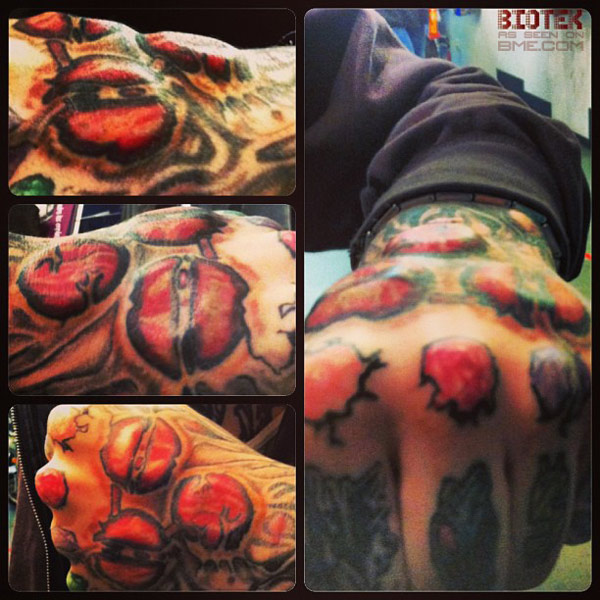In the depraved theme of the previous post, I caption this picture of Diego and his massive stretched piercings and eyeball tattoos: “Don’t you hate it when you stick your tongue in the wrong hole by accident?”
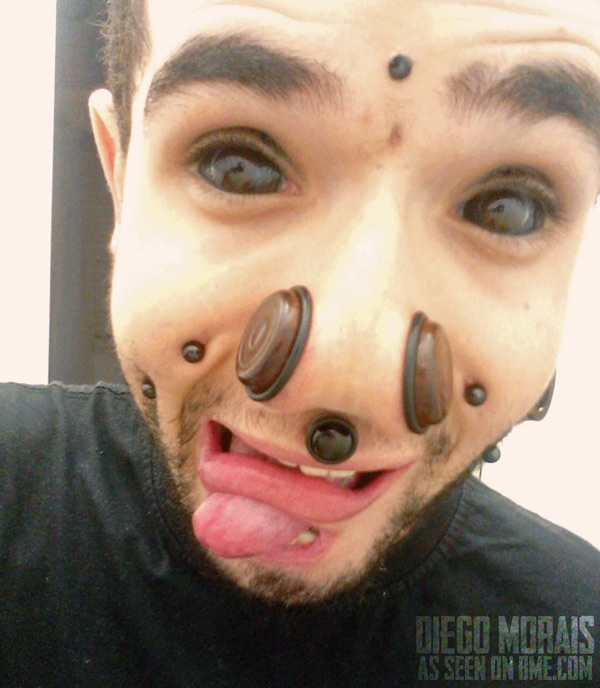
In the depraved theme of the previous post, I caption this picture of Diego and his massive stretched piercings and eyeball tattoos: “Don’t you hate it when you stick your tongue in the wrong hole by accident?”

This photo (in which I see Marc of Little Swastika and Roland, Oli, and Ralf of Visavajara) of a circular ring of people doing the suspension hook piercing of the person in front of them by being pierced by the one behind them is totally the suspension version of a daisy chain. And I’m not talking about the innocent sort…
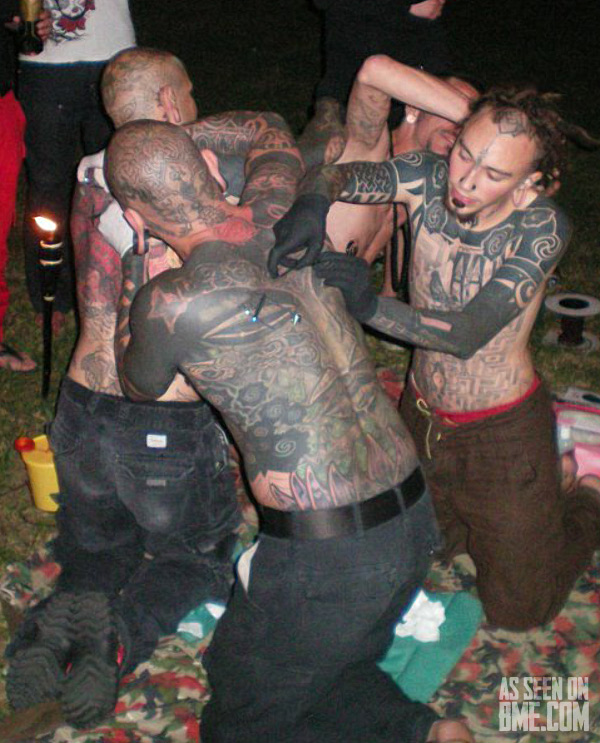
I’m sorry for waiting longer than I should have to write this; after the recent deaths of other body modification figures like ManWoman and Stalking Cat it’s difficult to have to follow those up with the loss of another significant body modification pioneer. Unfortunately I must write that Erl Douglas Van Aken II (see Erl on the BME wiki and his web page) passed away at his home after a richer life than anyone could ask for.
Erl was born in Brewer, Maine, and then moved to California at age four where he grew up in Orange County, a region he characterized as having “a very narrow band of perception, and being a person of ‘different’ thinking, not subject to peer pressure, I was not well… tolerated.” Always forward thinking, in the early sixties he worked in the space program at NASA, Bell Labs, JPL, and similar institutions where he worked on some of the first satellite programs, as well as Mercury, Gemini, and the Apollo program where he contributed significantly to the rover (moon buggy) — “in that sense I’m on the moon,” he said.
Wanting to explore a wider range of expression and not really fitting in to an increasingly “professional” environment, Erl left to become a multi-media artist, working in nearly every medium — as well as doing a lot of “motorcycle riding and hell raising during this period as well — you know, sex, drugs and rock’n’roll”, a dangerous lifestyle that would nearly cost him his life “on more than one occasion”. In the mid-90s (by which point he was a well-established body modification icon already) he began modelling for fine art, which lead to him joining the Screen Actors Guild (usually credited as Erl Van Douglas, although many of his non-speaking roles are uncredited, such as his 1996 appearance in The Cable Guy, the first movie I remember seeing him in — and my favorite thing about that movie). Lance Richlin, an artist who recently painted a series of portraits of Erl wrote me saying,
“Erl was no ordinary man. He was a Mystic. He had deep insight. The body modification was literally only the surface of the man. I didn’t even notice it after the first few encounters. When he was younger, he was a dangerous fellow. But he became a very gentle and compassionate man in old age.”
Although body modification was only a small part of a much more complex personality, Erl’s role in the world of body modification was significant. While the name has fallen out of fashion in favor of the anatomical moniker “bridge piercing”, for a long time “Erl” was what the piercing was called (as in “I’d like to get an Erl piercing”), as Erl was the first person known to wear it (done for him by The Gauntlet). Erl wasn’t only an early piercing and tattoo fan and innovator — he was also one of the first heavy body modification enthusiasts whose focus was significantly aesthetic. There have always been heavy mod practitioners, but the vast majority until the mid-nineties were doing it in private, almost exclusively in a sexual realm. Erl on the other hand was not only one of the first people in the West to explore surgical body mods on an artistic level, but also to do it “out”, sharing his love for it with those around him — for example, his radical and way, way, ahead of its time bipedical flap procedure was documented in Body Art magazine. Thereby he influenced many of the early body modification artists, as well as inspiring other serious enthusiasts, and changed culture more than he probably realized.
On the left, a recent painting of Erl by artist Lance Richlin (visit him at lancerichlin.com), and on the right, a pre-firing sculpture of Erl by Nicholas Mestanas (visit him on Facebook) — note that the piece includes Erl’s chest implants and bipedical flap (the artist was planning on adding the piercings post-firing).
Finally a few photoshoot images from Erl’s webpage — visit justerl.com to explore more.
Whether the name “Erl piercing” returns or falls out of our language, Erl’s pioneering exploration of body modification and the impact it had on popular culture lives on in hundreds of thousands of people’s lives — to say nothing of the myriad of other positive ways he touched those around him.
I’ve posted about Joeltron’s (of Australia’s FirstBlood at joeltron.com and firstblood.com.au) “trondustrials”, ear projects that tend to be on the… how do I put it… chaotic end of the spectrum (for example). This one though, built up using components from industrial strength, is a little more structured, with the three spikes of the trident coming out the back of the inner conch, and the handle curving around to grab hold of the inner curve of the helix, making for a very unique and well-done placement.
Speaking of Grace Neutral (I just posted a great set of breast/nipple tattoos she did), I also wanted to update everyone on the amazing skin peel that Howie (lunacobra.net) did on her a while back. It’s healed now, and remains one of my all-time favorite facial scars, not just because of how technically well executed it is, but the unique design. It came about naturally over a few days of Grace and Howie talking about it, followed by drawing it up one night at the shop, tweaking it into perfection. With the ideal design on her face in marker, this is what they created. Her ear points are also Howie’s work by the way.
Grace Neutral, a tattoo artist who specializes in handpoked work and is based in South London (although she travels regularly so don’t let that limit you — find her on Facebook or Tumblr) just did this incredible set of breast/nipple tattoos on Rebecka. Painwise, she tells me that the nipples hurt like crazy, but that it’s likely that doing them handpoked rather than grinding the ink in with a machine probably reduced the pain significantly. Click either picture for a bigger version.
As you know, I like seeing pieces that combine multiple body art disciplines, and I thought this was an elegant example of scarification used alongside tattooing, each artform contributing to the part of the design they’re best able to execute. Unlike many tattoo/scar combos, where the tattoos (or sometimes the scars) are added as an afterthought or “upgrade” long after the initial mod is well healed, this example was designed as such from the beginning. The scarification portion was performed by Binho Barduzzi of Familia Amorim Tattoo Shop in Lisbon, and the tattoo by was done by his friend Rafa. The piece is well healed now as it was cut back in 2009, so I wish I could show you a healed picture of it but unfortunately their client lives in Brazil, practically on the other side of the planet from them in Portugal.
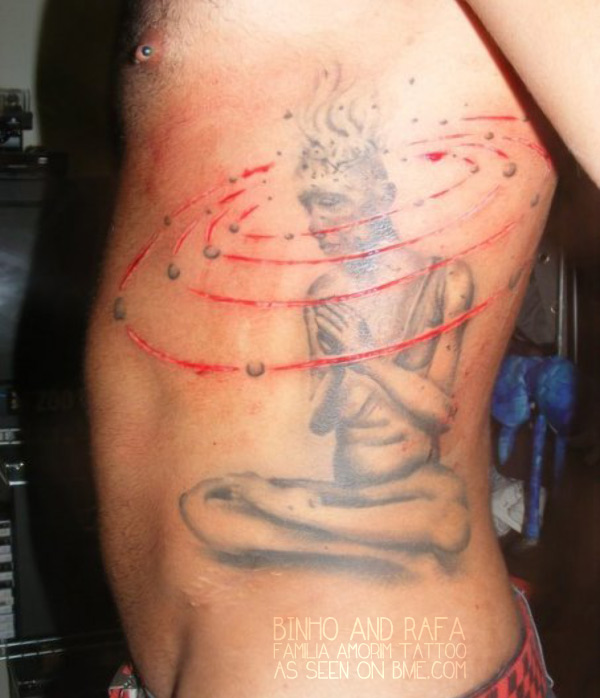
I’ve sort of gotten hooked on reading these old patent records related to body modification, and just came across one that surprised me because of how ahead-of-its-time it was. In early 1875, Albert S. Baker of Somerville, MA filed a patent for what he called an “Imrpovement in Ear-rings” (US Patent #161,853). The patent is for a small gauge flanged tunnel to be worn in the earlobe — he explains,
“It is well known that in the use of ear-rings, as ordinarily constructed, the wires frequently tear out or cut the ear, and when not made of proper materials poison the parts with which they come in contact, thus sometimes causing great injury to the wearer. My invention is designed to obviate these difficulties and objections.”
He goes on to describe the device (which he calls a “spool” at times), which he instructs should be made of high quality gold, thus eliminating materials reactions such as nickel allergies. In addition, because the device is larger gauge than the fine wire that often makes up the hook of an earring, it reduces the chance of the jewelry pulling through. What, you thought Todd Bertrang was the first person to tell the world these things? Still, I was pleasantly surprised to see these concepts tossed around in detail nearly 140 years ago.
Many later jewelry designs also presented similar ideas (his appears to be the first hollow tunnel that was patented), but I will just very briefly mention another one of them, a patent filed in 1976 by Mary C. Ivey of Atlanta, GA (US Patent #4,067,341). Her concept is almost identical, and she explains it very similarly in her application, but adds that her design both allows the secondary jewelry more freedom to move due to the tunnel being larger, and also suggests taking advantage of advances that have been made in materials sciences (specifically plastics) to improve the design. Unfortunately she’s vague on many aspects (as is frustratingly common in patents) and does not however come out and say the actual diameter of the tunnel — as pictured I’m guessing in the realm of 8ga.
As you can see in those illustrations, the visual effect of someone wearing these tunnels — or “pierced earlobe protector” as Ms. Ivey titles it — is very, very close to someone wearing a small gauge tunnel of the sort we see all the time walking out the doors of your friendly neighborhood piercing studio. The one thing that neither Ivey nor Baker mention in their patents how the piercing is to be done, which I’m curious about, especially with Ivey’s, which seems to be getting too big to just shove into your average hole*. The only such insertion-method explanation I stumbled across regarding this style of jewelry was one filed in 1949 by Robert W. Spicher of Havre, MT (US Patent #2,568,207) for a “Surgical Piercing Device”.
The jewelry itself is superficially similar in design and intent to the others in this entry, but it also includes a sharpened taper that can be tightly fitted over the tunnel, either creating the new piercing hole or squeezing into an existing one, and then expanding that hole. The particularly creative part is that he then uses a syringe to blow air into the tunnel to make the taper pop off like a champagne cork — hopefully not shooting like a tiny bullet into the wearer’s neck! — to be replaced with a cap that keeps the tunnel from falling out.
______
* “that’s what she said”
An incredibly disturbing video — probably the most offensive tattoo video to date — is currently doing the viral rounds. In it, the tattoo artist (whose face we never see), tattoos what appears to be a small “666″ on a toddler that screams in pain and terror while he’s doing it. A woman that I assume is the mother is holding the child down the whole time. Since there is parental consent in the process, it is 100% legal. Arguably this isn’t any worse than the doctors that have have cut off the ends of millions if not billions of baby boys’ penises to satisfy their parents religious or cultural leanings, and of course there are indigenous cultures (many of them idolized by the “modern primitive” movement) all around the world that do a wide variety of heavy mods on babies and children… But wow… I don’t think I could bring myself to be involved in something like this, either as the artist or the parent. But I wonder — how many of you who are willing to denounce this video are also willing to denounce the tribal cultures who do similar things in much larger quantities and to a more horrific extent, or even denounce circumcision which is still commonplace in America (although not many other Western nations at this point as the cruelty and needlessness is recognized)?
YouTube pulled the video — click here to download our backup or play it here:
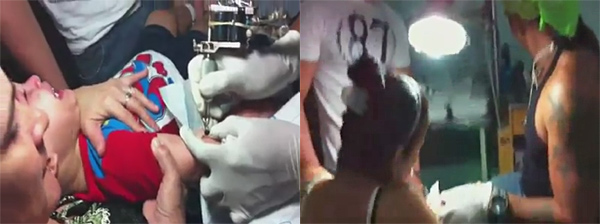
Update: If I had to guess [edit #2: this is now confirmed, and if you listen in the video you can hear them say that the child is now “blessed by Jesus”], I would say these people are followers of Jose Luis de Jesus of Growing in Grace. Followers of this fringe religion often get 666 tattooed one them as a part of their faith. The question is, do you believe in freedom of religion? Where is that line drawn for you? This group even has billboards around Toronto where I live — this isn’t just some isolated event. Below are some other similar tattoos done by their followers:
Update #2: Trying to find examples of tattooed children in Western culture, I was hoping to dig up an old story in BME’s old newspaper archive of historical mod stories because I remembered one about a father taking his identical twin sons to a tattoo artist in order to get a beauty mark tattooed on one of them as a way of telling them apart more easily. Anyway, I couldn’t find the actual article I was searching for, but I did find another from the October 19, 1899 Twin City News which mentions how an increasing number of parents are tattooing their children with a hidden ID mark (I believe this was in the midst of abduction paranoia).
Also, I mentioned above that the parents were “100%” legally in the right (although not ethically in my opinion), but I should point out that there have been cases — for example, this North Carolina mother arrested after allowing her 11-year-old to get a tattoo of a small heart on her shoulder — that suggest the opposite. However, courts in America are very unlikely to call the actions of an established religion “child abuse”, so don’t expect to see Jews being jailed over circumcision any time soon.
Here’s a great example of combining implants with tattoos. Hugo Ferreira of BIOTECH in Toulouse, France has taken some of Max Yampolskiy’s ring implants and put them into Noss’s hand, augmented with red tattoos that not only match the implants but his knuckles as well. I should add that the tattoos were there before the implant, making Hugo’s job much more difficult, but as you can see he lined them up beautifully.
